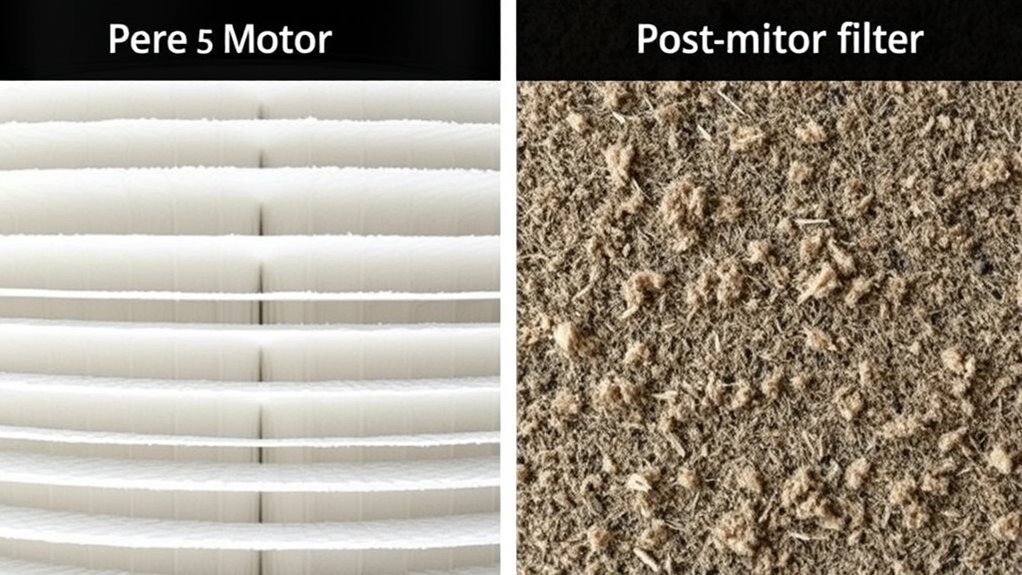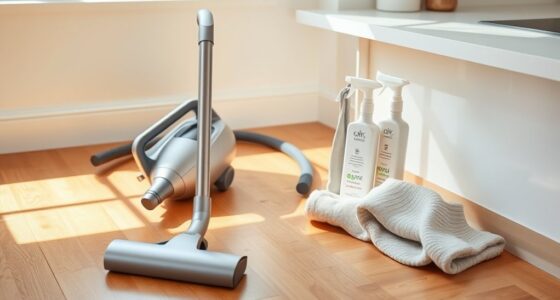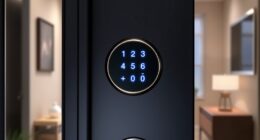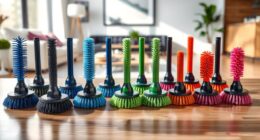Understanding the difference between pre-motor and post-motor filters helps you keep your vacuum running effectively. Pre-motor filters trap large debris and protect the motor from damage, while post-motor filters catch tiny allergens and improve indoor air quality. Regularly maintaining both filters ensures ideal suction and cleaner air. If you want to learn more about how these filters work together and how to care for them, you’ll find helpful insights ahead.
Key Takeaways
- Pre-motor filters protect the motor from large debris, while post-motor filters trap microscopic allergens for cleaner air.
- Proper maintenance and replacement of both filters are essential for optimal vacuum performance and air quality.
- HEPA post-motor filters are highly effective at capturing allergens, whereas pre-motor filters mainly prevent motor damage.
- Filter lifespan varies from 3-6 months; neglecting replacement reduces suction and filtration efficiency.
- Choosing the right filter depends on specific cleaning needs, such as allergy control or durability requirements.
Understanding the Basics: What Are Pre-Motor and Post-Motor Filters?

Pre-motor and post-motor filters are essential components of many vacuum cleaners, and understanding their roles can help you maintain peak performance. Pre-motor filters trap dust, dirt, and allergens before they reach the motor, protecting it and enhancing HEPA effectiveness for cleaner air. These filters should be checked regularly because their filter lifespan varies depending on usage and environment. A clogged pre-motor filter reduces suction power and can compromise the vacuum’s efficiency. Post-motor filters, on the other hand, capture remaining particles after the motor, ensuring that exhaust air is purified. Both filters work together to improve air quality and prolong your vacuum’s life. Knowing when to replace or clean these filters keeps your vacuum functioning best and maintains effective filtration. Additionally, understanding the importance of security measures in home safety can help protect your investment and loved ones from potential threats.
How Pre-Motor Filters Protect Your Vacuum’s Motor
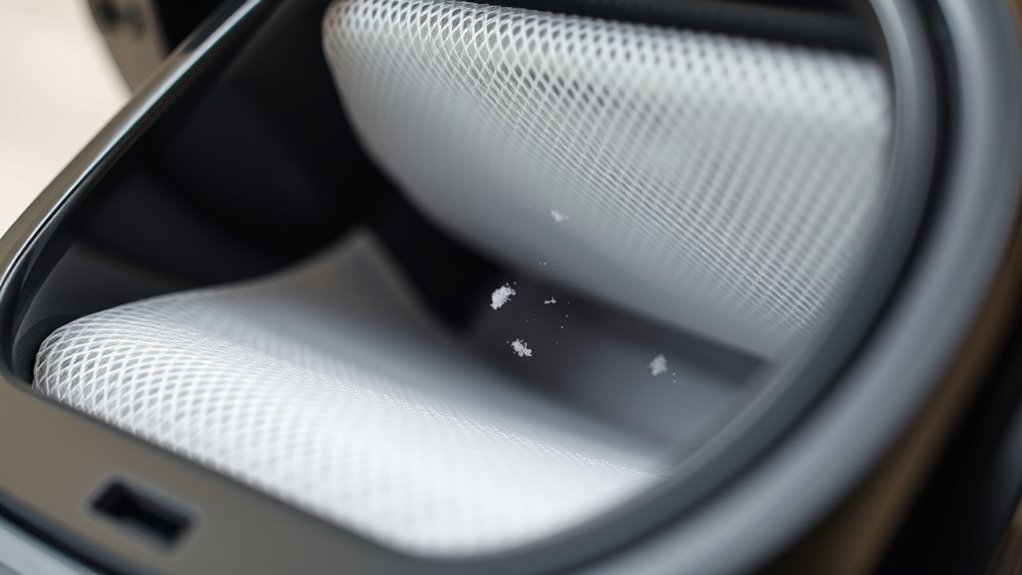
Pre-motor filters catch dust and debris before they reach your vacuum’s motor, keeping it clean and efficient. By trapping these particles, they prevent potential damage and overheating. This protection helps your vacuum last longer and perform better over time. Additionally, maintaining a clean filter can improve the overall suction power and efficiency of your vacuum. Color accuracy and other factors are essential for image quality in projectors but are also relevant when considering the quality of components in your home appliances.
Trap Dust and Debris
A essential role of pre-motor filters is trapping dust and debris before they reach your vacuum’s motor. This prevents clogs and maintains suction power, guaranteeing efficient cleaning. HEPA-compatible filters excel at allergen trapping, capturing tiny particles like pollen, pet dander, and dust mites. This is especially helpful if you suffer from allergies or asthma. By filtering out these irritants, your vacuum improves indoor air quality. The table below highlights key benefits of trap dust and debris with pre-motor filters:
| Benefit | Explanation |
|---|---|
| Allergen trapping | Captures microscopic particles to reduce allergens in the air |
| HEPA compatibility | Ensures high-efficiency filtration for sensitive users |
| Prolongs motor life | Keeps debris away from motor components |
| Maintains suction | Prevents blockages that reduce cleaning power |
| Improves air quality | Removes airborne irritants during vacuuming |
Additionally, understanding trap dust and debris can help you choose the right filter to enhance your vacuum’s performance and longevity.
Prevents Motor Damage
By filtering out dust, hair, and debris before they reach the motor, pre-motor filters play an essential role in preventing damage to your vacuum’s fundamental components. They guarantee that harmful particles don’t bypass the main filter and enter the motor, which could lead to overheating or mechanical failure. This dust trapping capability provides critical motor protection, extending your vacuum’s lifespan. Without a pre-motor filter, fine dust and debris could accumulate inside the motor, causing wear and tear or even motor burnout over time. Additionally, toilet flushing mechanisms can impact airflow and internal contamination, so maintaining clean filters is vital for optimal performance. By maintaining cleaner airflow and reducing internal contamination, these filters help keep your vacuum running smoothly. In short, pre-motor filters are a simple yet effective way to safeguard your investment and ensure consistent cleaning performance.
The Role of Post-Motor Filters in Air Quality and Exhaust
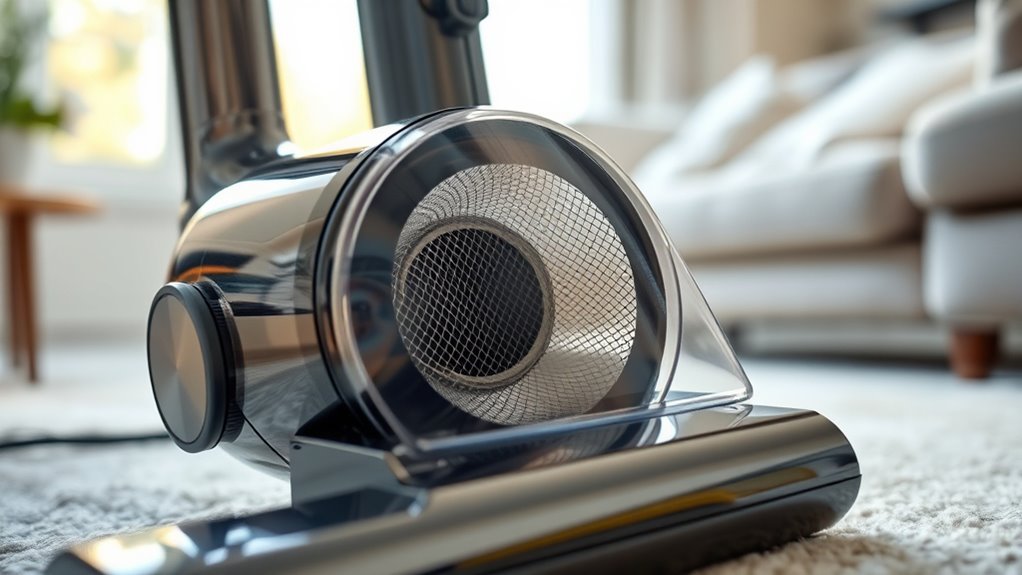
Post-motor filters play a key role in improving your home’s air quality by trapping fine particles before they’re recirculated. They also help control exhaust emissions, reducing odors and harmful pollutants. Understanding their function can help you choose a vacuum that keeps your environment cleaner and healthier. Proper maintenance of filter systems ensures optimal performance and longevity of your vacuum, contributing further to a healthier indoor environment.
Air Purity Enhancement
Have you ever wondered how air filters improve overall air quality and exhaust? Post-motor filters with HEPA efficiency play a vital role in this process. They trap tiny particles, including allergens, dust mites, and pet dander, preventing them from recirculating into the air. This means cleaner air for you and better allergen removal, especially if you have sensitivities or allergies. These filters work behind the scenes, capturing residual particles that escape the main filter, enhancing overall purification. By reducing airborne contaminants, post-motor filters help maintain a healthier indoor environment. When you choose a vacuum with an effective post-motor filter, you’re investing in improved air purity and ensuring that exhaust emissions contain fewer pollutants, making your home safer and more comfortable. Additionally, filtration methods in vacuum systems are designed to maximize removal of pollutants from the air and exhaust.
Exhaust Emission Control
Post-motor filters do more than just improve indoor air quality—they also play a key role in reducing exhaust emissions from your vacuum. By trapping fine particles and allergens before air exits the machine, these filters help guarantee cleaner exhaust, improving overall air quality. Their filter lifespan is vital; a worn or clogged filter won’t effectively remove allergens or contaminants, leading to increased emissions. Regularly replacing or maintaining your post-motor filter maximizes allergen removal and keeps exhaust emissions low. This not only benefits your indoor environment but also extends the vacuum’s performance. Proper exhaust emission control is essential for allergy sufferers and anyone concerned with air purity. Investing in a high-quality, well-maintained filter ensures your vacuum operates efficiently, providing cleaner air with every use. Additionally, understanding filter maintenance can help prolong the life of your vacuum and ensure optimal air quality.
Comparing Efficiency and Filtration Capabilities
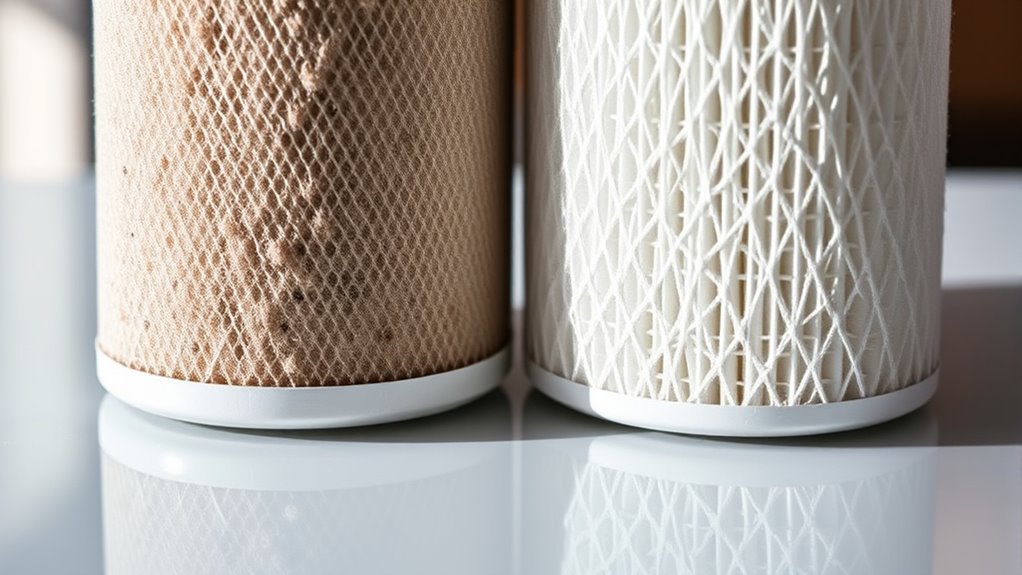
While both pre-motor and post-motor filters aim to improve air quality, they differ considerably in efficiency and filtration capabilities. Pre-motor filters typically target larger dust particles, filtering debris before reaching the motor, which helps protect it. Post-motor filters focus on finer dust particle sizes, capturing allergens and microscopic particles to improve air quality. Their filter material composition also varies; pre-motor filters often use foam or simple synthetic materials, while post-motor filters employ HEPA or advanced synthetic fibers for higher filtration efficiency.
| Filter Type | Dust Particle Size | Filter Material Composition |
|---|---|---|
| Pre-motor | Larger dust particles | Foam, synthetic fibers |
| Post-motor | Finer dust particles | HEPA, high-grade synthetic fibers |
Maintenance, Replacement, and Longevity of Each Filter Type

Maintaining and replacing filters regularly is essential to guarantee your vacuum operates efficiently and continues providing clean air. The filter lifespan varies between pre-motor and post-motor filters, typically ranging from three to six months, depending on usage and environment. Pre-motor filters need more frequent replacement if you vacuum often or have allergies, while post-motor filters tend to last longer but should still be checked regularly. To ensure peak performance, clean reusable filters as recommended and replace disposable ones when they show signs of damage or clogging. Following the suggested replacement frequency helps prevent motor strain and maintains suction power. Proper maintenance extends each filter’s longevity, saving you money and ensuring your vacuum keeps your space clean and allergen-free. Regular maintenance is key to maximizing your vacuum’s lifespan and effectiveness.
Choosing the Right Filter Based on Your Cleaning Needs
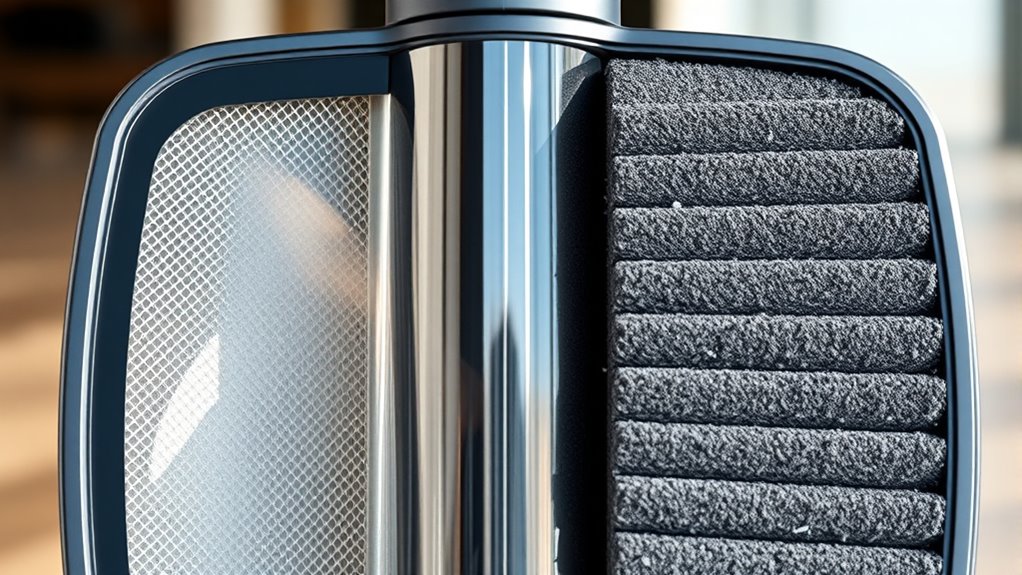
Choosing the right filter depends on your specific cleaning needs and environment. If you have allergies or respiratory sensitivities, opt for filters with a longer filter lifespan that effectively trap allergens and fine dust particles. HEPA filters, for example, are ideal for allergy considerations because of their high-efficiency filtration. Consider how often you’ll need to replace or clean your filter, as a longer lifespan reduces maintenance frequency. If you live in a dusty area or have pets, selecting a filter designed to handle higher debris loads will ensure better air quality and cleaner floors. Assess your cleaning environment carefully to choose a filter that balances filtration efficiency with durability, helping you maintain a healthier home while minimizing replacement costs. Additionally, understanding the filter types can help you select the most suitable option for your needs.
Common Misconceptions About Vacuum Filters and Their True Functions
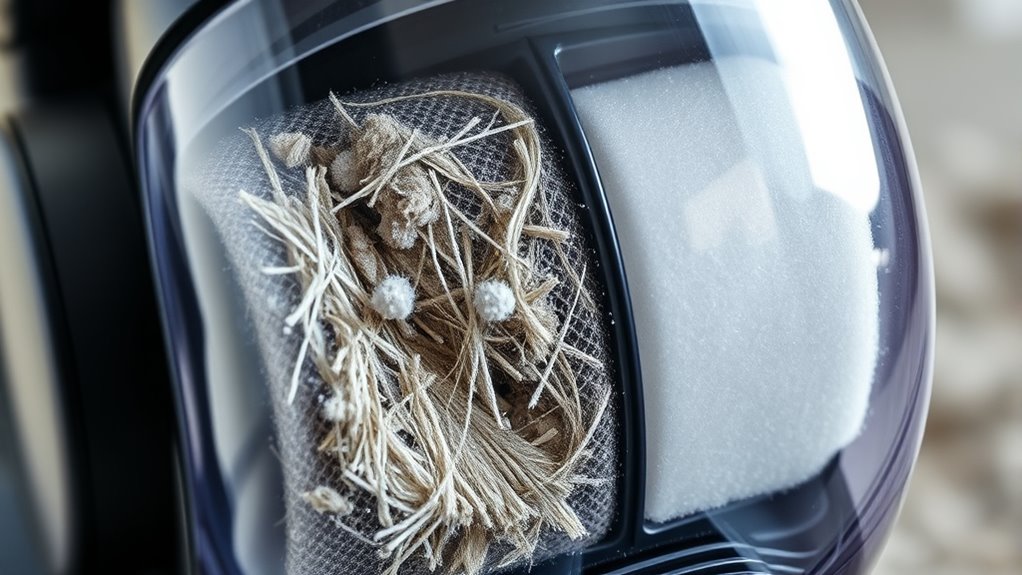
Many people assume that all vacuum filters work the same or that their primary role is just to trap dirt. In reality, filters have different functions, and understanding their true roles helps you maximize their effectiveness. For example, pre-motor filters are designed to protect the motor and improve airflow, while post-motor filters focus on trapping allergens and fine particles. A common misconception is that replacing filters frequently isn’t necessary, but filter lifespan varies, impacting overall performance and allergy considerations. Neglecting this can lead to reduced suction and poor air quality, especially for allergy sufferers. Knowing the true functions of each filter helps you maintain your vacuum better, ensuring it works efficiently and keeps your indoor air cleaner. Additionally, using quality control measures during manufacturing ensures that filters perform their designated functions effectively, contributing to better overall vacuum performance.
Frequently Asked Questions
Can Using the Wrong Filter Void My Vacuum’s Warranty?
Using the wrong filter can indeed void your vacuum’s warranty if it affects filter compatibility and damages the machine. Manufacturers often specify compatible filters, so ignoring these guidelines may lead to warranty implications. To protect your investment, always use the recommended filters for your vacuum model and check warranty terms before making replacements. That way, you guarantee your vacuum stays covered and performs at its best.
Are There Eco-Friendly Alternatives to Traditional Pre- and Post-Motor Filters?
Yes, there are eco-friendly options like biodegradable filters and reusable alternatives. You can choose filters made from natural, compostable materials that break down easily, reducing landfill waste. Reusable filters, often washable and durable, cut down on waste and the need for frequent replacements. By switching to these greener options, you help protect the environment while maintaining your vacuum’s performance. Always check compatibility before making the switch.
How Do Filters Affect a Vacuum’s Suction Power Over Time?
Think of your vacuum’s filters as the lungs of a marathon runner. Over time, as filter lifespan approaches, suction degradation occurs, making it harder for your vacuum to breathe and clean effectively. Clogged or dirty filters restrict airflow, reducing suction power. Regularly replacing or cleaning filters keeps the airflow smooth, ensuring your vacuum maintains peak power and performance, much like a runner keeps steady with proper training and care.
Can I Upgrade My Vacuum With Higher-Grade Filters for Better Performance?
You can definitely upgrade your vacuum with a higher-grade filter for a performance boost. Look for filters designed for your specific model, like HEPA or advanced pre-motor filters, to improve airflow and trap more allergens. Installing a filter upgrade may require some effort, but it can extend your vacuum’s lifespan and enhance cleaning efficiency. Just make certain the new filter is compatible to avoid any damage or reduced suction.
What Are Signs Indicating My Filters Need Replacing Sooner?
When your vacuum’s filters start to discolor or emit strange odors, it’s a red flag waving wildly. These signs mean your filters are clogged with dirt and debris, struggling to breathe and work efficiently. If you notice reduced suction, increased dust escape, or persistent smells, it’s time to replace them. Don’t ignore these cues—they’re your vacuum’s way of telling you it needs fresh filters to keep your home clean and healthy.
Conclusion
Now that you know the difference between pre-motor and post-motor filters, you’ll see they’re both essential for your vacuum’s performance and your home’s air quality. Regular maintenance keeps everything running smoothly, saving you time and money in the long run. Don’t put all your eggs in one basket—pay attention to both filters to get the best results. After all, a well-maintained vacuum is the key to a cleaner, healthier home.
